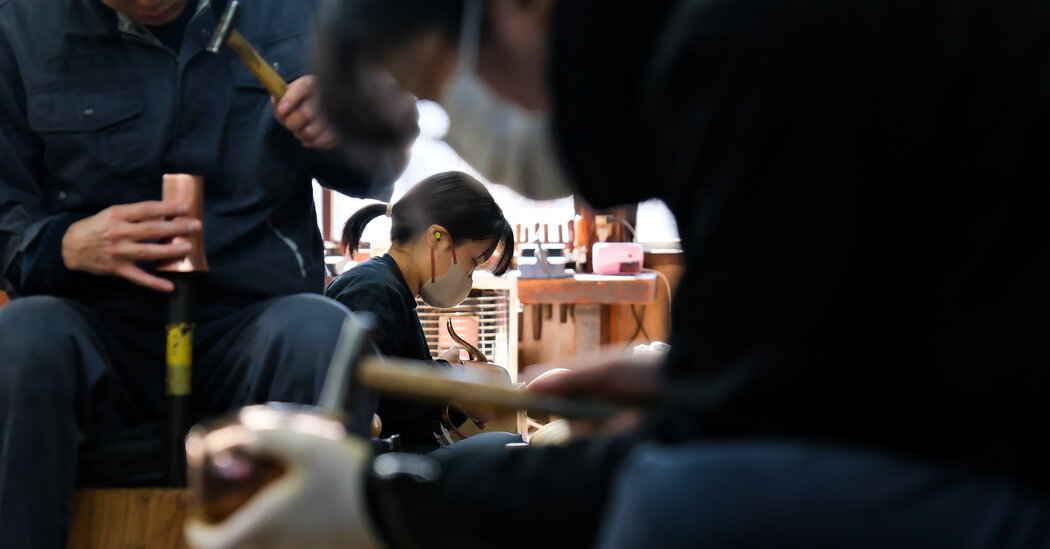A friend recently showed me one of the handmade sake cups that he adores. It was a deep midnight blue rounded copper cup sprinkled with gold flecks, like a starry sky. And it was made by Gyokusendo, a family company established in 1816 that specializes in tsuiki, the Japanese term for copperware hammered by hand.
“The cups’ design was actually started during my generation,” said Motoyuki Tamagawa, the company’s president and the seventh family member to lead the business. “The designs and colors are thought up by the artisans themselves.”
And if the sake cup (16,000 yen, or about $110) isn’t the gift you are looking for, the design also is used on an elongated version with curved edge, sold as a beer cup (¥21,000 to ¥23,000).
Gyokusendo is headquartered in Tsubame, a city on the western side of Japan’s main island of Honshu, about two hours by high-speed train from Tokyo.
While the stop is labeled Tsubame-Sanjo, “it actually serves two cities, Tsubame (population 76,694) and Sanjo (population 92,364),” Keizo Sekikawa of the Tsubamesanjo Regional Industries Promotion Center wrote in an email. “Both cities are active in metalworking and manufacturing.”
And if you didn’t know that before departing the train, you would quickly learn it: Several glass cases just outside the ticket gates display metal items made by local artisanal businesses, including Gyokusendo, as well as more automated operations such as Yukiwa, known in the international bar industry for tumblers, cocktail shakers, stirring spoons and other accessories. And some of the products are sold in the large showroom at the rear of the station.
Why metalworking? It all started with iron nails. Rice continues to be one of the region’s primary crops, but about 400 years ago residents tired of coping with the area’s frequent flooding began to make iron nails called wakugi (which are not common now, but are still used for traditional buildings).
Eventually the area started producing items including bonsai scissors and cutlery, and perfecting techniques such as the mirror polish used on the original 2001 iPod.
A Different Connection
Gyokusendo is housed in a 110-year-old building, a registered cultural property that includes a showroom, a workshop and Mr. Tamagawa’s house.
“We’ve been making copperware for over 200 years,” he said. “And it’s very important for us to continue to do that, particularly with the hand-hammered technique that we employ and to be faithful to that technique.”
While Gyokusendo originally sourced copper from nearby Mount Yahiko, now the company buys from local distributors who primarily get the metal from Indonesia and several countries in South America.
Customers can visit the business’s shop in the Ginza district of Tokyo, the workshop in Tsubame or order directly by email. And some items are sold online by Tea Dealers, a specialty shop in the United States, as well as Amleto Missaglia, a shop in Milan.
For Mr. Tamagawa, however, it is very special for customers to come to Tsubame.
“The reason to bring people here is to see the artisans working,” he said. “When you use a piece that you know was made by the people that you saw, you have a very different connection to it. The way that you may care for it, use it or regard it is much different.”
The workshop is 300 square feet, with tatami floors, and on this particular day its large windows filled the room with light, reflected off the snow outside. In the center, a large rack held about 200 anvil stakes, used to texture and shape the copper, while another 200 hammers and mallets of different shapes and sizes filled cupboards and lined the walls.
The room was completely silent, aside from the regular hammering rhythm.
Gyokusendo employs 18 artisans — seven women and 11 men — and their average age is 34.
As I walked around the workshop, Yamato Tanaka, 33, was hammering away at a beer cup. “The most difficult part is to hammer it without affecting the curved shape,” he said, displaying the rounded edges of its bottom.
He joined Gyokusendo in 2017, as a clerk in the Ginza shop, and was allowed to join the team of artisans two years later, even though he had not had any formal metalwork training. “The traditional way was to watch and learn from the senior artisans,” he said. “But that approach has changed. I’ve been taught how to use the tools and which steps to take.”
Masumi Tsuchida, 30, a colleague who joined the company in 2018, agreed with the description. “We rely on the more experienced artisans,” she said. “And often the onus is on us to ask them questions.”
Sake or Tea
According to the Japanese Sake Association, the shape and thickness of a cup can affect the taste of sake (it’s not uncommon in high-end Japanese bars for patrons to be offered a collection of cups, so they can select the size and shape they prefer).
I had never tried sake in a copper cup, so I tasted sake poured in a copper cup adorned with deep blue dots (¥15,000) as well as a cup made of glass. The copper cup was cool to my lips as well as my fingers, and the drink seemed more refreshing. (Copper cups can also be used for atsukan, or hot sake, and warm the drinker’s hands.)
“As sake is becoming appreciated all over the world, those would be a good gift idea,” Mr. Tamagawa said, noting that cups can be packaged in a paulownia wood box that he routinely decorates with black ink.
And while the sake ware is popular, so is the seamless spout teakettle, formed from a single sheet of copper and with a woven handle (¥850,000).
Mr. Tamagawa noted that the copperware pieces aged well and, as a gift, can become a kind of heirloom that “creates a bridge between the hearts and minds of family across generations.”







